
Acer saccharinum, commonly known as silver maple, creek maple, silverleaf maple, soft maple, large maple, water maple, swamp maple, or white maple, is a species of maple native to the eastern and central United States and southeastern Canada. It is one of the most common trees in the United States.

Acer campestre, known as the field maple, is a flowering plant species in the family Sapindaceae. It is native to much of continental Europe, Britain, southwest Asia from Turkey to the Caucasus, and north Africa in the Atlas Mountains. It has been widely planted, and is introduced outside its native range in Europe and areas of USA and Western Australia with suitable climate.

Abies pinsapo, the Spanish fir, is a species of tree in the family Pinaceae, native to southern Spain and northern Morocco. Related to other species of Mediterranean firs,

Dipterocarpus retusus, commonly known as hollong, is a large tree and perhaps the best known species in the genus Dipterocarpus. It is native to China, Vietnam, Philippines, Laos, Cambodia, Malaysia, Indonesia, Myanmar, and India. The tree, some 20–30 metres (70–100 ft) tall, is found in Cambodia in dense forests of the plains, common on hillsides and along rivers and in forests between 800 m (2,600 ft) and 1,500 m (5,000 ft) altitude.

Picea smithiana is a species of evergreen tree in the family Pinaceae family It is referred to by the common names morinda spruce and West Himalayan spruce, and is a spruce native to the western Himalaya and adjacent mountains, from northeast Afghanistan, northern Pakistan, India to central Nepal. It grows at altitudes of 2,400-3,600 m in forests together with deodar cedar, blue pine and pindrow fir.
Dipterocarpus costulatus is a species of tree in the family Dipterocarpaceae. It grows up to 50 metres (160 ft) tall.

Acer monspessulanum, the Montpellier maple, is a species of maple native to the Mediterranean region from Morocco and Portugal in the west, to Turkey, Syria, Lebanon, and Israel in the east, and north to the Jura Mountains in France and the Eifel in Germany.
Acer duplicatoserratum is a species of maple, native to southern and eastern mainland China and Taiwan.

Euphorbia leuconeura is a species of flowering plant in the family Euphorbiaceae. Its common name is Madagascar jewel. It is endemic to Madagascar where its natural habitat is forest undergrowth in rocky areas. It can grow to a height of 1.8 m (6 ft), as a branching small tree, and propagates by shooting its seeds several feet into the air. It is threatened by habitat loss.
Shorea obtusa, the Siamese sal, is a species of hardwood tree in the family Dipterocarpaceae, native to Southeast Asia.
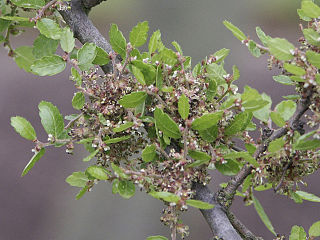
Zelkova abelicea is a species of tree in the family Ulmaceae. It is referred to by the common names Cretan zelkova, and on Crete proper as abelitsia (αμπελιτσιά). It is endemic to Crete. It is found in small numbers and is classified as Vulnerable on the IUCN red list of endangered species.
Euphorbia remyi is a rare species of flowering plant in the family Euphorbiaceae. It is known by the common name Remy's sandmat locally as ʻakoko. It is endemic to the island of Kauaʻi in Hawaii, where it grows in mixed mesic forests, wet forests and bogs from 150 to 900 m.

Acer heldreichii is a species of flowering plant in the Sapindaceae family. It is referred to by the common names Heldreich's maple, mountain maple, Greek maple, and Balkan maple is a European species of maple. It is native to Albania, Bulgaria, Greece, North Macedonia, Montenegro, Kosovo, Serbia, and Bosnia-Herzegovina.
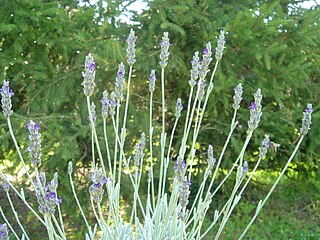
Lavandula lanata, the woolly lavender, is a species of flowering plant in the family Lamiaceae, native to southern Spain. An evergreen dwarf shrub growing to 1 m (3.3 ft) tall and broad, it is noted for the pronounced silver woolly hairs on its leaves, whence the Latin specific epithet lanata. The deep violet purple flowers are borne on narrow spikes, and give off the familiar lavender scent.
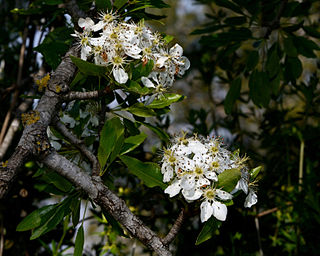
Pyrus syriaca is a deciduous tree in the Rosaceae family. It is referred to by the common name Syrian pear. It is the only pear species which grows in the wild in Lebanon, Turkey, Syria and Israel.
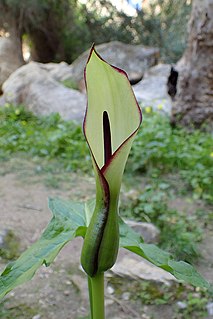
Arum hygrophilum is a species of flowering plant in the family Araceae. It has a disjunct distribution, found in Israel, Jordan, Lebanon, Syria, Cyprus and Morocco.
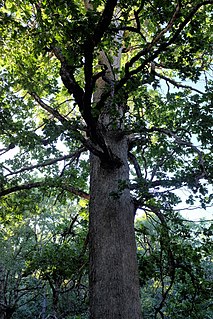
Quercus vulcanica is a species of flowering plant in the Fagaceae family. It is referred to by the common name Kasnak oak, and is a rare species of tree native to Lebanon, Syria, and Turkey.
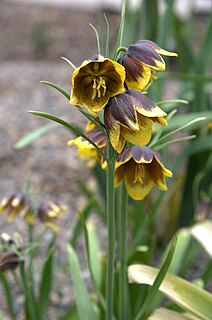
Fritillaria reuteri is a perennial herbaceous bulbous plant, distributed in Turkey and Iran. It is a species in the genus Fritillaria, in the family Liliaceae. It is placed in the subgenus Fritillaria.

Acer pycnanthum, Japanese red maple, is a species of maple native to Japan, and introduced to Korea. A tree usually about 20 m, reaching 30 m, it prefers to grow in relict mountain wetlands. It flowers in April, prior to the emergence of leaves. Although considered Vulnerable in its native habitat, it has found some use as a street tree, and is the official tree of a number of Japanese municipalities and of Aichi Prefecture.
Acer wilsonii,, is a species of flowering plant in the genus Acer, native to southeast and south-central China. It is considered by some authorities to be a subspecies of Campbell's maple, Acer campbellii subsp. wilsonii, but this is incorrect; it is in its own species complex. A tree typically 10 to 15 m tall, it prefers to grow in forests 900 to 2000 m above sea level.
















